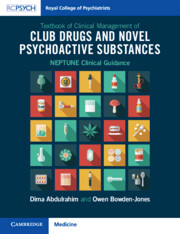 Textbook of Clinical Management of Club Drugs and Novel Psychoactive Substances
Textbook of Clinical Management of Club Drugs and Novel Psychoactive Substances Book contents
- Textbook of Clinical Management of Club Drugs and Novel Psychoactive Substances
- Textbook of Clinical Management of Club Drugs and Novel Psychoactive Substances
- Copyright page
- Contents
- Acknowledgements
- Part I Introduction and Background
- Part II Drugs with Primarily Depressant Effects
- Part III Drugs with Primarily Stimulant Effects
- Chapter 8A Introduction to Stimulant Club Drugs and Novel Psychoactive Substances
- Chapter 8B Amphetamine-type Stimulants: An Overview
- Chapter 9 ‘Ecstasy’: MDMA (3,4-Methylenedioxy-N-Methylamphetamine), MDMA Analogues and Drugs with Similar Effects
- Chapter 10 Methamphetamine
- Chapter 11 Synthetic Cathinones
- Part IV Drugs with Primarily Hallucinogenic Effects
- Part V Synthetic Cannabinoid Receptor Agonists
- Part VI Concluding Remarks
- Index
- References
Chapter 8B - Amphetamine-type Stimulants: An Overview
from Part III - Drugs with Primarily Stimulant Effects
Published online by Cambridge University Press: 06 October 2022
- Textbook of Clinical Management of Club Drugs and Novel Psychoactive Substances
- Textbook of Clinical Management of Club Drugs and Novel Psychoactive Substances
- Copyright page
- Contents
- Acknowledgements
- Part I Introduction and Background
- Part II Drugs with Primarily Depressant Effects
- Part III Drugs with Primarily Stimulant Effects
- Chapter 8A Introduction to Stimulant Club Drugs and Novel Psychoactive Substances
- Chapter 8B Amphetamine-type Stimulants: An Overview
- Chapter 9 ‘Ecstasy’: MDMA (3,4-Methylenedioxy-N-Methylamphetamine), MDMA Analogues and Drugs with Similar Effects
- Chapter 10 Methamphetamine
- Chapter 11 Synthetic Cathinones
- Part IV Drugs with Primarily Hallucinogenic Effects
- Part V Synthetic Cannabinoid Receptor Agonists
- Part VI Concluding Remarks
- Index
- References
Summary
Amphetamine-type stimulants (ATS) are world-wide the second most popular group of drugs after cannabis (UNODC, 2019)23 and a significant proportion of NPS with stimulant effects are ATS.
The World Health Organization (WHO) defines amphetamine-type stimulants (ATS) as a group of drugs whose principal members include amphetamine and methamphetamine. A range of other substances also fall into this group, such as methcathinone, ephedrine, pseudoephedrine, methylphenidate and 3,4-methylenedioxy-methamphetamine(MDMA).
Globally, seizures of ATS increased sharply from the second half of the 1990s until 2001 and over the period 2009–2017.24 The largest number of seizures in the past few years have been methamphetamine, followed by amphetamine, ‘ecstasy’ type substances, other stimulants (MDPV, methcathinone, methylone, several other cathinones, dimethoxyamphetamine and several piperazines) and prescription stimulants.
- Type
- Chapter
- Information
- Textbook of Clinical Management of Club Drugs and Novel Psychoactive SubstancesNEPTUNE Clinical Guidance, pp. 146 - 164Publisher: Cambridge University PressPrint publication year: 2022


